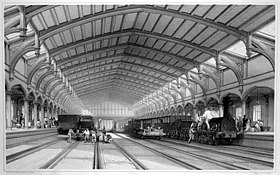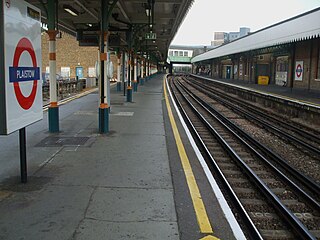
Plaistow is a London Underground station on Plaistow Road in the London Borough of Newham in Greater London. It is between West Ham and Upton Park stations on the District and Hammersmith & City lines, and in Travelcard Zone 3.
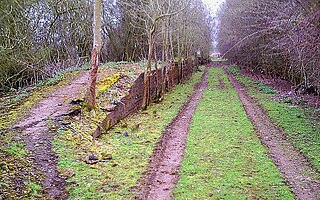
An abandonedrailway station is a building or structure which was constructed to serve as a railway station but has fallen into disuse. There are various circumstances when this may occur – a railway company may fall bankrupt, or the station may be closed due to the failure of economic activity such as insufficient passenger numbers, operational reasons such as the diversion or replacement of the line. In some instances, the railway line may continue in operation while the station is closed. Additionally, stations may sometimes be resited along the route of the line to new premises – examples of this include opening a replacement station nearer to the centre of population, or building a larger station on a less restricted site to cope with high passenger numbers.
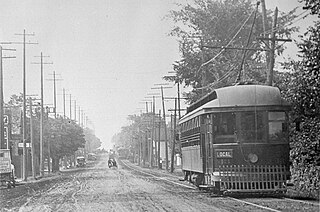
The Metropolitan line in the Toronto area, operated by the Metropolitan Street Railway, started out as a local horsecar line and transformed itself into an electric radial line extending to Lake Simcoe, following an old stage coach route. In 1904, the railway was acquired by the Toronto and York Radial Railway (T&YRR) and became the T&YRR Metropolitan Division. In 1922, the City of Toronto acquired the T&YRR and contracted Ontario Hydro to manage the four T&YRR lines including the Metropolitan. In 1927, the TTC took over the operation of the Metropolitan Line to Sutton, and renamed it the Lake Simcoe line. In 1930, the TTC closed the Metropolitan Line but shortly reopened the portion between Glen Echo and Richmond Hill operating it as the North Yonge Railways until 1948.

Birmingham Curzon Street railway station was a railway station in central Birmingham, England. Initially used as a major early passenger terminus before being eclipsed by newer facilities and converted into a goods depot, it was a continuously active railway facility up until 1966.

Bournemouth railway station is the main railway station serving the seaside town of Bournemouth, Dorset, England. It was previously known as Bournemouth East and then Bournemouth Central. It has long been treated as an obligatory stop on the South West Main Line from London Waterloo to Weymouth. It is 108 miles 2 chains (173.8 km) down the main line from Waterloo and is situated between Pokesdown and Branksome.

Green Park railway station is a former railway station in Bath, Somerset, England. For most of its life, it was known as Bath Queen Square.

Manchester Central railway station was a railway station in Manchester city centre, England. One of Manchester's main railway terminals between 1880 and 1969, the building was converted into an exhibition and conference centre which was opened in 1986, originally known as G-MEX, but now named Manchester Central. The structure is a Grade II* listed building.

Middlesbrough is a railway station on the Durham Coast Line, Esk Valley Line and Tees Valley Line. The station serves the town of Middlesbrough in North Yorkshire, England. It is owned by Network Rail and managed by TransPennine Express. Direct destinations include Darlington, Saltburn, Sunderland, Newcastle, York, and Manchester Airport. There is a direct service to London Kings Cross once per weekday.
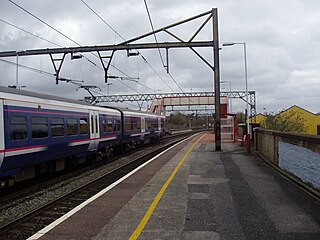
Ashburys railway station serves the area of Openshaw, in Greater Manchester, England. It is a stop on a junction of the Glossop Line, the Hope Valley line and the freight line to Phillips Park Junction. It has been open since 1855 and is the nearest station to the City of Manchester Stadium.

Bow was a railway station in Bow, east London, that was opened in 1850 by the East & West India Docks and Birmingham Junction Railway, which was later renamed the North London Railway (NLR). The station was situated between Old Ford and South Bromley, and was located on the north side of Bow Road, close to the second Bow Road station which was open from 1892 to 1949. A covered footway connected the two stations between 1892 and 1917.

Toronto and Scarboro' Electric Railway, Light and Power Company was established in August 1892 to provide street railway service to the Upper Beaches district within the City of Toronto, Ontario and to the neighbouring Township of Scarborough. Except for two branches, the line ran as a radial along Kingston Road.
Oldham Clegg Street railway station was the Oldham, Ashton-under-Lyne and Guide Bridge Junction Railway station that served the town of Oldham in northwest England, it had three associated goods stations.

Artscape Wychwood Barns is a community centre and park in the Bracondale Hill area of Toronto. The converted heritage building was built as a streetcar maintenance facility in 1913. It now contains artist housing and studios, public green space, a greenhouse, a farmer's market, a beach volleyball court, a theatre, a dog run, and office space for many local community groups. The site is a total of 5,574 square metres.

A train station, railroad station, or railroad depot and railway station is a railway facility where trains stop to load or unload passengers, freight, or both. It generally consists of at least one platform, one track, and a station building providing such ancillary services as ticket sales, waiting rooms, and baggage/freight service. Stations on a single-track line often have a passing loop to accommodate trains travelling in opposite direction.

Leslie Barns is a streetcar maintenance and storage facility at the southeast corner of Leslie Street and Lake Shore Boulevard in Toronto, Ontario, Canada. It has been built to house and service the majority of Toronto Transit Commission's fleet of Flexity Outlook light rail vehicles.
The Plaistow Carhouse was a historic streetcar carhouse at 27 Elm Street in Plaistow, New Hampshire. Built in 1901, it was a surviving reminder of a short-lived trolley service that served the town until 1930. It was listed on the National Register of Historic Places in 1980 and was demolished around 1985.
Teddington Park is a neighbourhood in Toronto, Ontario, Canada. It is bordered by Yonge Street to the west and Bayview Avenue to the east, and from Snowden Road in the south to north of Glen Echo Road and Rosedale Golf Club. Development occurred in and around the 1930s, and was farmland before that time.

The St. Clair Carhouse was a streetcar facility in Toronto, Ontario, Canada. It was located south of St. Clair Avenue on a parcel of land bounded by Wychwood Avenue on the east, Benson Avenue on its north side and Christie Street on the west side. It was opened by the Toronto Civic Railways in 1913, taken over by the Toronto Transportation Commission in 1921 and closed by its successor, the Toronto Transit Commission, in 1998. The carhouse was subsequently transformed into a community centre called the Wychwood Barns.
